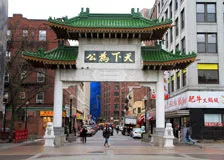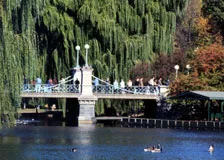Our History
Tufts Medical Center has had a number of medical firsts. More than 200 years ago, the roots of our Medical Center were planted by several compassionate Bostonians, including American patriots Samuel Adams and Paul Revere. In 1796, these public-minded individuals founded the Boston Dispensary, a facility dedicated to the care of the poor. Between 1856-1899, the Dispensary established the first medical clinic, the first dental clinic and the first lung clinic in the United States. By 1918, the Dispensary had created the first evening pay clinic, a well-child clinic, a preventative health clinic and the first food clinic.
Tufts Medical Center began as a hospital ship, sailing the Boston Harbor for the first time in 1894. The mission of the ship was to take ill urban children out onto the harbor to experience the healing qualities of fresh sea air and sunshine. Importance was placed on family centered care, as parents were encouraged to participate in their childrens’ healthcare. In the late 1920s, Tufts Medical Center left the harbor waters and moved its facilities on land.
In 1929, the Boston Dispensary entered into an arrangement with the Boston Tufts Medical Center and Tufts College Medical School, to form New England Medical Center (which we know today as Tufts Medical Center). Since then, Tufts Medical Center has been on the forefront of medical innovation with advances like establishing the world’s first pediatric trauma center, inventing artificial milk (later called Similac) and discovering the modern syphilis test.
Our Neighborhood

Boston is the largest city in New England but it’s easy to quickly find your way around. Tufts Medical Center is located in downtown Boston, next to Chinatown and the Theater District and within walking distance of the South End, Back Bay, Boston Common, Downtown Crossing and Faneuil Hall neighborhoods.
We share the Tufts Medical Center campus with several Tufts University science and professional schools, including Tufts University School of Medicine. The campus is close to a number of historical sites, fitness facilities, hotels and restaurants.
The Tufts Medical Center Orange Line stop is located across from the main hospital entrance on Washington Street. Other nearby MBTA stops are Downtown Crossing (Red Line, Orange Line) and Boylston (Green Line). Tufts Medical Center is a 15-to-20-minute cab ride from Logan Airport and within walking distance of South Station. View our campus map and directions.
Living in Boston

Boston is a vibrant city that is full of history. From the Boston Tea Party to the Battle of Bunker Hill and the Midnight Ride of Paul Revere, our city has seen some of the pinnacle times in our nation’s growth. Walking along the streets of Boston (we recommend the Duck Boat Tour or a walk along the Freedom Trail) you can still visit many of the city’s famous landmarks.
Boston is also home to a wide number of universities and major health care institutions. In fact, the city has the nation’s highest concentration of colleges, with many alumni who stay after graduation to work and live in the city. This large population of young adults creates an atmosphere of people who are eager to network, get to know one another and have fun.